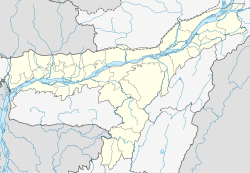Sadiya
|
Sadiya শদিয়া Sadia |
|
|---|---|
| town | |
| Nickname(s): Starting point of Assam | |
| Location in Assam, India | |
| Coordinates: 27°50′N 95°40′E / 27.83°N 95.67°ECoordinates: 27°50′N 95°40′E / 27.83°N 95.67°E | |
| Country |
|
| State | Assam |
| District | Tinsukia |
| Elevation | 123 m (404 ft) |
| Languages | |
| • Official | Assamese |
| Time zone | IST (UTC+5:30) |
| Vehicle registration | AS |
Sadiya (Assamese: শদিয়া, Meaning: Sa-Corpse, Diya-Given) was the third capital of Sutiya Kingdom established by the second Sutiya ruler Ratnadhwajpal in 1248 and remained as the capital till 1524. Extensive remains of buildings and fortifications built during the rule of the Sutiyas near about Sadiya still point to the importance of the region in the past. It is located in the Tinsukia district of the North-eastern Indian state of Assam. Its stands on a grassy plain, nearly surrounded by forested Himalayan mountains, on the right bank of what is locally (but erroneously) considered the main stream of the Brahmaputra river. Sadiya is famous for a flower named sotful (the word means "blessing" or a "desert flower"), which is much like Jasmine.
The Gauda ruler possibly Khesav Sen made friends with the Sutiya king Ratnadhwajpal (Gaurinarayan) who sent one of his son to that country for education. Unfortunately, the Sutiya Prince died there and the corpse was sent to Gaurinarayan. At the time of the arrival of the corpse, Gaurinarayan was engaged in building a new city. He named the city as Sadiya (Sa:Corpse, Diya:Given)
Sadiya was built by Gaurinarayan, the second ruler of the Sutiya dynasty during the mid 13th century and remained as the capital till the 16th century. Sadiya was the extreme north-east frontier station of British Raj, in the Lakhimpur district of Eastern Bengal and Assam regions. On the opposite bank is a railway station which used to connect with the Assam-Bengal line of that era. Sadiya had been garrisoned by detachments of native infantry and military police, and was the base of a chain of outposts. There had a bazaar, to which the hill-men beyond the frontier—Mishmis, Abors, and Khamtis—used to bring down rubber, wax, ivory, and musk, to barter for Cotton cloth, salt and metal goods. In 1943-44 there was a United States Army Air Force (USAAF) field at Sadiya which hosted the 89th Fighter Squadron of the 80th Group, headquartered at Nagaghuli, now Chabua Air Base of the Indian Air Force. Sadiya today serves as one of the district headquarters for Indian Red Cross.
...
Wikipedia


